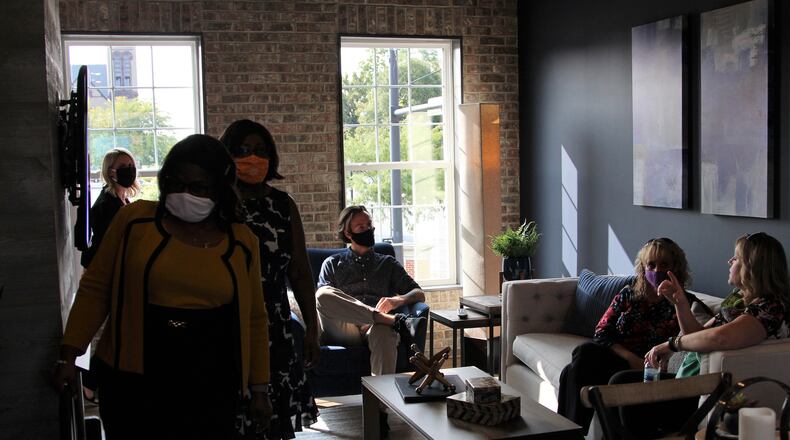That is also coinciding with efforts to improve preexisting homes and neighborhoods, through investment strategies or targeting blighted properties.
Both counties have a large number of aging homes and have seen limited new housing developments in recent decades.
A comprehensive housing market analysis completed last year for the City of Springfield found that 50% of its housing units were built before 1949.
The analysis was produced by the Greater Ohio Policy Center and that organization stated at the time that they firmly believe “new market rate housing is needed and will be purchased in Springfield if new housing is available at a range of price points.”
A similar analysis conducted in Champaign County and released this year found that 75% of homes there were built before 1990. It was also found that about 80% of new home construction since 2010 has occurred outside municipal boundaries in that county.
Both reports made recommendations to what could be done to further stimulate growth. Those included continued focus on downtown revitalization efforts, supporting future development projects as well as continued efforts to lower financial risk.
In Springfield, efforts to bring in more housing as well as reexamine preexisting housing stock in the city has been part of larger redevelopment efforts.
“We continue to have conversations with developers about additional housing in our community. We need to address housing at all levels. This includes apartments to single family residential units,” said Springfield City Manager Bryan Heck.
Several housing construction projects continued to move forward in the city amid the coronavirus pandemic. Those included a housing development that aims to bring over 200 new homes to the area as well as a separate project to build a total of 34 townhomes downtown.
Construction for both those projects began last year and have led to home sales. The development known as Bridgewater is slated to bring 231 homes altogether on 53-acres of land.
There has not been a significant housing development built in Springfield since the early 1990s, city officials said.
The project is to be built in four-phases and lots will be made available. Virtual tours are being conducted at model homes built at the property for potential buyers. Construction of the actual homes will start after they are sold.
The bulk of those homes will be located just south of the Tuttle Road Walmart along with an additional 15-acre tract to the east of that Walmart.
So far, 71 lots are available as part of the first phase of the project and 51 have been sold, Heck said.
Infrastructure work has started for the second phase of the project with the hopes of adding 59 lots. That phase is slated be completed by November, Heck added.
DDC Management is the firm developing the property used for the Bridgewater development and Ryan Homes is in charge of construction.
Another project that aims to add more housing in the city is moving on schedule.
The first building has been completed in a project that aims to construct a total of six buildings, which will house 34 town homes. Each unit will be three-stories, have an attached garage and two bedrooms.
The town homes are about 1,300 square feet and prices for the units start at around $220,000. However, future homeowners will also have a 15-year property tax exemption as the area is considered one for community revitalization.
Construction on the first building, which contains six units, including one model, wrapped up over the summer. So far, four units in that building have already been sold with some of the buyers already moving in.
The project is titled Center Street Townes and is being developed by Charles Simms Development. A ribbon cutting ceremony was held to debut its model home on Wednesday.
“This is a joyous occasion as we continue the revitalization and the rebirth of our downtown. Springfield’s downtown has come a long way over the last 10 years,” Heck said during the ceremony on Wednesday.
However, the model home has been used for tours over the last several weeks and has seen at least 75 groups checking out the property, said Charlie Simms, the president of the company.
Framing for the second building, which will contain four units, started in March and construction is slated to be completed by the end of this year. Simms said two of the units in that building have already been sold.
He said the demand has prompted the start of site work for the third building and framing is expected to start in November. That building, which will have six units, is expected to be done by the end of the summer in 2021.
“So we are going a head and starting that (third) building because really we only have three (units) available right now. The buildings take like 6 to 8 months to build. So we want to be able to have inventory available for people to move in next year,” Simms said.
He said construction has moved on schedule for the most part, citing that certain materials, such as lumber, became less available. The coronavirus pandemic had an impact on the supply chain.
However, the project as a whole is expected to wrap up in 2022.
In Champaign County, a housing consortium has been established and began meeting recently. The goal is to look at different ways to foster housing development.
That can include looking at existing zoning and rules as well as what can be done to aid developers in starting projects in the county. The goal is to ensure a good return on housing investments in the community for all those that are involved.
Marcia Bailey, the director of the Champaign Economic Partnership, said that traditionally housing sales are good in the county. But, a major challenge is a lack of housing inventory in the market, she added.
However, a project that aims to bring affordable senior living to downtown Urbana is moving forward.
Renovations are slated to start soon at the the old Douglas Hotel as well as the former Urbana North and South Elementary Schools. The goal is to transform those properties into 51 apartments.
Those units are expected to be done and ready to be leased by next year.
Bailey said that can free up available housing stock in the area as some will transition to the apartments and possibly sell their homes.
By the numbers:
231: homes that will be part of the Bridgewater development in Springfield
34: number of town homes that will be built in downtown Springfield as part of Center Street Townes
51: number of affordable senior living apartment units as part of the Legacy Place project in downtown Urbana.
About the Author

